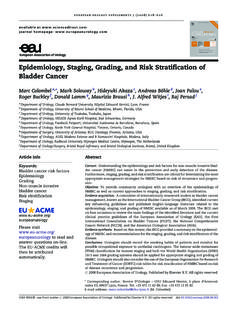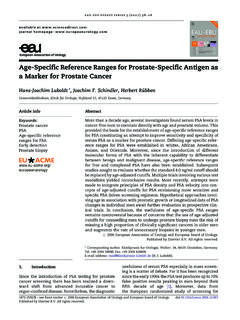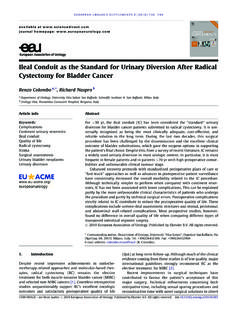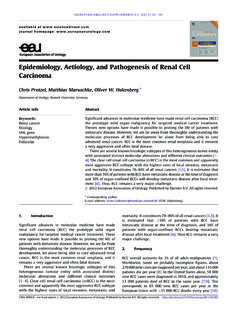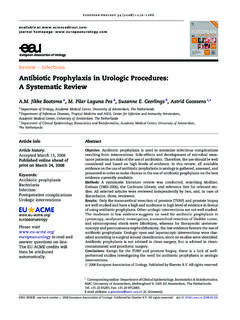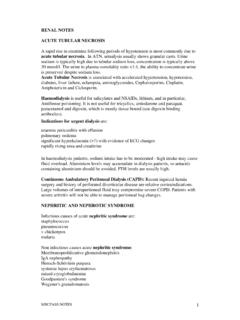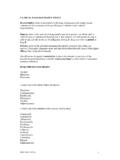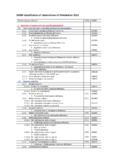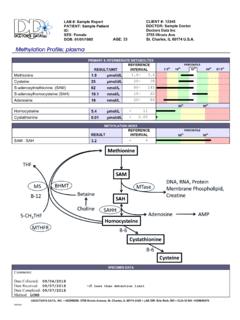Transcription of Cystinuria—Diagnosis and Management - EU-ACME
1 cystinuria Diagnosis and ManagementChandra S. Biyania,*, Jon J. CartledgebaPinderfields General Hospital, Wakefield, UKbSt James s University Hospital, Leeds, is a rare but important cause of urinarystone disease. It is an autosomal recessive defect inamino acid transport manifest in the formation ofcystine urinary calculi[1]. Amino acids are freelyfiltered by the glomerulus and are almost comple-tely re-absorbed by proximal tubular cells. In normalindividuals of filtered cystine is lost in theurine[2]. Two transport mechanisms, a high and alow-affinity system, are responsible for cystine re-absorption in the proximal tubular cells. In cysti-nuria the absorption of cystine, along with the threeother dibasic amino acids, ornithine, arginine &lysine, via the high affinity process is reduced[3,4].
2 It is the insolubility of cystine that leads to thepathological process of calculus article will review the current knowledge ofthe genetic basis of cystinuria , outline the patho-physiology of the disease and highlight 1% of adult and 6% of paediatricstones are cystine[5]. The prevalence of cystinuriaglobally is 1 per 7000 with widespread variation: UKeau-ebu update series 4 (2006) 175 183available at homepage: infoKeywords:CystinuriaGeneticsDiagnosis Medical managementAbstractCystinuria is an autosomal recessive disorder of cystine and dibasicamino acid transport across the luminal membrane of proximal tubuleand small intestine. Two responsible genes have been identified: muta-tions in theSLC3A1gene, located on the chromosome 2p, cause cysti-nuria type I, while variants inSLC7A9have been demonstrated in non-type I cystinuria .
3 The poor urinary solubility of cystine can lead to stoneformation in affected individuals which typically manifests in thesecond and third decades of life. Typical Management involves copiousoral fluid intake, urinary alkalisation and thiol medications to decreasethe urinary cystine concentration below 300 mg/l. Recurrent stoneformation necessitates repeated urological interventions. Fortunately,contemporary minimally invasive approaches to stone treatment areapplicable in the treatment of cystine stones. The Management ofcystinuria is often challenging and requires a close co-operationbetween radiologist, nephrologist and urologist.#2006 Published by Elsevier behalf of European Association of Urology and European Board of Urology.* Corresponding author.
4 Department of Urology, Pinderfields General Hospital,Mid Yorkshire Hospitals NHS Trust, Aberford Road, Wakefield, West Yorkshire,WF1 4DG, UK. Tel. +44 1924 212027; Fax: +44 1924 Biyani).1871-2592/$ see front matter#2006 Published by Elsevier behalf of European Association of Urology and European Board of :2000; Australia 1:4000; Japan 1:18 000; Sweden1:100 000; Libyan Jews 1:2500. Incidence is equalbetween the sexes but men may be more severelyaffected[6,7]. Although the peak incidence of firstcystine calculus is 22 years of age, almost 1/4 ofcytinurics will develop stones in the first decade oflife with 30 40% of patients having their first stonein the teenage years[8]. addition to the renal tubular malfunction ofcystinuria cystine absorption from the intestine isimpaired[9].
5 Cystine deficiency is not clinicallysignificant since the absorption of cystine is unaf-fected. The clinical picture of cystinuria thereforeremains a problem of stone presence of elevated levels of urinary cystineis important due to the insolubility of cystine inurine at physiological pH. Up to pH 7 cystinesolubility is approximately 250 mg/L urine whilstabove pH this will double to 500 mg/L and tripleat pH 8 or greater[10]. The ionic component of urinewill impact upon cystine solubility. Increasing theionic strength of a solution from to willpermit an additional 70 mg of additional cystine tobe absorbed per litre of solution[11]. The nature ofthe electrolyte component of this ionic solution isalso important, calcium chloride increasing solubi-lity to a greater extent than magnesium chloride andsodium chloride respectively[11].
6 Is an autosomal recessive disease for-mally classified into 3 subtypes summarised inTable 1 [12,13]. Clinical classification of cystinuriarequires the measurement of urinary cystine levelsin patients (Table 2).The first cystinuria geneSLC3A1encodes theglycoproteinrBATsubunit of the heterodimertransporter in intestinal and renal epithelial cells,located on chromosome 2 (2p21)[14].SLC3A1isexpressed in cells of the proximal tubules (segment1to segment3). Up to 80 mutations ofSLC3A1aredescribed in cystinuria [13,15]. Most mutations ofthis gene tend to be population-specific. The M467 Tmutation for example accounted for 40% of muta-tions in a cohort of Spanish families but was rare inpatients studied in Quebec, Canada[15,16].A second cystinuria geneSLC7A9on chromosome19 (19q13) encodes the light chain b0,+AT.
7 Mutationsof this gene probably cause non-type I cystinuria [17]. Multiple mutations of this gene are reported,G105R is the most common mutation[15]. The mostcommon described in a group of Libyan Jewsresulted in methionine replacing the valine aminoacid residue (V170M) in the transcribed protein. Inheterozygotes with the V170M mutation, urinarycystine concentrations range from 86 to 1238 micro-mol/g of creatinine. Some V170M heterozygotesexcrete cystine in the range consistent type IIIdisease and others with type II disease[17,18].Recently, Dello Strologo et al.[19]have proposed anew genetic classification, as follows:eau-ebu update series 4 (2006) 175 183176 Table 1 Sub-classification of cystinuria by genetic characteristicsRosenberg et al.[12]Type IType IIType IIIM olecularType INon Type IUrinary cystine, lysine, arginine & ornithine in heterozygotesNormalElevatedElevatedActiv e intestinal transport in homozygotesCystineAbsentPresentPresentLy sineAbsent PresentArginineAbsentNot knownPresentResponsible affectedMediterranean Spanish persons, 40%Libyan JewsAmino acid transport system localization inproximal converted tubuleSegment 3 (S3>S1,S2)Segment 1 & 2(S1,S2>S3)Table 2 Urinary cystine concentrationNormal<30 mg/day ( mmol/day)Homozygote cystinuria >400 mg/day ( mmol/day)Majority form stonesHeterozygote Type I<200 mg/day ( mmol/day)Do not form stonesHeterozygote Type II & III200 400 mg/day ( mmol/day)May form stones Type A, mutation of both alleles ofSLC3A1.
8 Heterozygotes show a normal amino acid urinarypattern. Type B, mutation of both alleles ofSLC7A9:Heterozygotes usually show an increase of cystineand dibasic amino acid urinary excretion. Type AB, cystinuria caused by 1 mutation inSLC3A1and 1 mutation inSLC7A9: Mixed-typecystinuria may be caused by the interaction of 2distinct mutant genes, and the protein encoded bythe 19q gene directly interacts with rBAT in the S3segment of the proximal practical purposes at present extensivegenetic sub classification of cystinuria seems unim-portant in the short-term, but may facilitate futuremolecular or gene therapy. The determination ofcystine concentration in urine will confirm adiagnosis and guide the intensity of future manage-ment. Although a significant amount of research hasbeen conducted in this field, many questionsremained unanswered.
9 Why 55% of cystinuricsdevelop stones? Are there other nongenteic fac-tors/genes/transporters involved in the process? accurate and early diagnosis of cystinuria isimportant in the long-term Management ofpatients. All patients should have a baseline renalfunction and blood pressure recorded. Homozygouscystinuria is characterized by lifelong, recurrentstone disease that is difficult to manage, bothsurgically and medically. More than 50% of asymp-tomatic homozygotes develop kidney stones with75% of these patients presenting with bilateralcalculi[20].The clinical symptoms of cystine stone diseaseare identical to that of other metabolic causes ofrenal calculi. A high index of suspicion should beheld if the first stones are formed in the first 2decades of life, in early recurrent stone disease, inpatients with a family history of stone disease, andthose with recurrent UrinalysisMicroscopic examination of the urine may showhexagonal crystals that are pathognomonic ofcystinuria.
10 Cystine is one of the sulfur-containingamino acids; the urine may have the characteristicodour of rotten eggs. This may be particularlypronounced in the bladder urine drained followinglaser fragmentation of ureteric sodium-nitroprusside test is a rapid qualita-tive determination of cystine concentration that isno longer in routine clinical use. Cyanide breaks thedi-sulphide bond of cystine liberating cysteinewhich then binds nitroprusside, causing a purplehue in 2-10 minutes[21]. A false-positive result mayoccur in individuals with homocystinuria or acet-onuria, and in people taking sulfa containing drugs,ampicillin, or N-acetylcysteine. Fanconi syndromecauses a false-positive test secondary to generalizedaminoaciduria. We feel that this test is an excellentcheap screening procedure for classical cystinuria .

